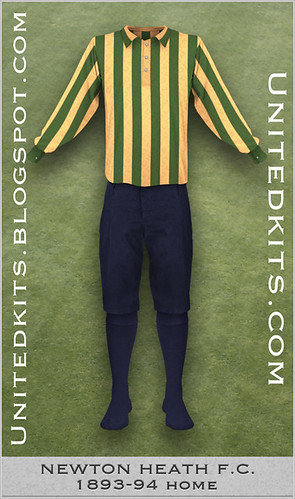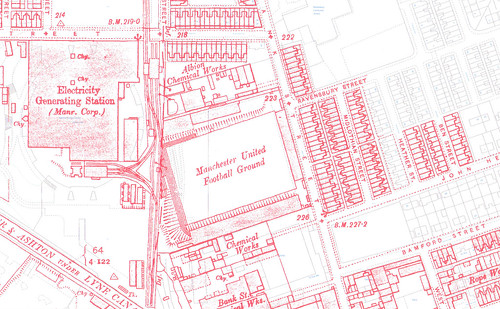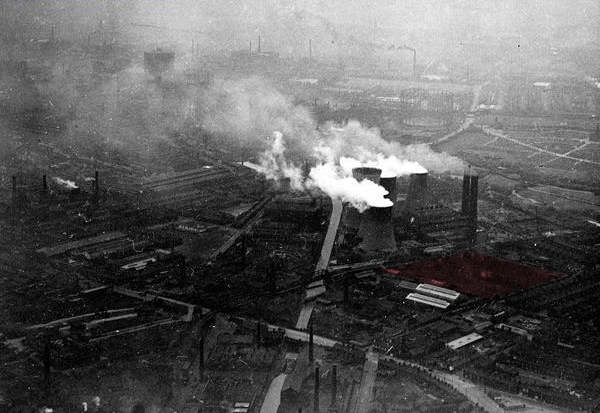The Heathens' first season in the Football League was not successful, and they were saved from relegation only by beating Small Heath - later to become Birmingham City - in the playoffs, or Test Matches, as they were then known (there was no automatic relegation and promotion between the two divisions at the time).
Also, the club had a further breakdown in their relationship with the railway company, who had increased the rent on their North Road ground (despite it being sub-let from Manchester Cathedral, who apparently were not in favour of charging spectators to attend matches there). It was obvious that Newton Heath would be forced to find themselves a new home.
A ground three miles away at Bank Street in Clayton was secured in time for the club to begin their league campaign the for the 1893-94 season and the kit was again changed - this time to green and gold striped shirt, navy kickers and socks:
Also, the club had a further breakdown in their relationship with the railway company, who had increased the rent on their North Road ground (despite it being sub-let from Manchester Cathedral, who apparently were not in favour of charging spectators to attend matches there). It was obvious that Newton Heath would be forced to find themselves a new home.
A ground three miles away at Bank Street in Clayton was secured in time for the club to begin their league campaign the for the 1893-94 season and the kit was again changed - this time to green and gold striped shirt, navy kickers and socks:
Unfortunately, the ground at Bank Street was no improvement on North Road. The pitch was just as bad, if not worse, but now there was the extra problem of toxic fumes from the adjacent chemical works that would leave the ground almost permanently shrouded in a thick, acrid haze. In fact, there was a power station to the other side and the site of the pitch itself had also previously been a chemical works!
That the club would, for a further nine years, keep the same name as when it played at Newton Heath caused much confusion for visiting teams and supporters, too.
That the club would, for a further nine years, keep the same name as when it played at Newton Heath caused much confusion for visiting teams and supporters, too.
Below is an aerial photograph of the Clayton area taken in the 1920s, the site of the ground is highlighted, but was disused at the time:
The luck that the Heathens had the previous season was to desert them at Bank Street, as they were again forced to fight for their First Division survival in the Test Match, but lost to Liverpool at Ewood Park.
The 1894-95 season would see them take their place in the Second Division alongside newly re-named neighbours Manchester City, then playing at Hyde Road in Ardwick. Once again, the Heathens switched their jerseys for the new season - to new green ones with gold collars, which they also wore the following season, along with white knickers and dark - possibly black - socks. The change kit is unknown, but may have simply been the same shorts and socks worn with any of the prevoius shirts.
The 1894-95 season would see them take their place in the Second Division alongside newly re-named neighbours Manchester City, then playing at Hyde Road in Ardwick. Once again, the Heathens switched their jerseys for the new season - to new green ones with gold collars, which they also wore the following season, along with white knickers and dark - possibly black - socks. The change kit is unknown, but may have simply been the same shorts and socks worn with any of the prevoius shirts.






No comments:
Post a Comment